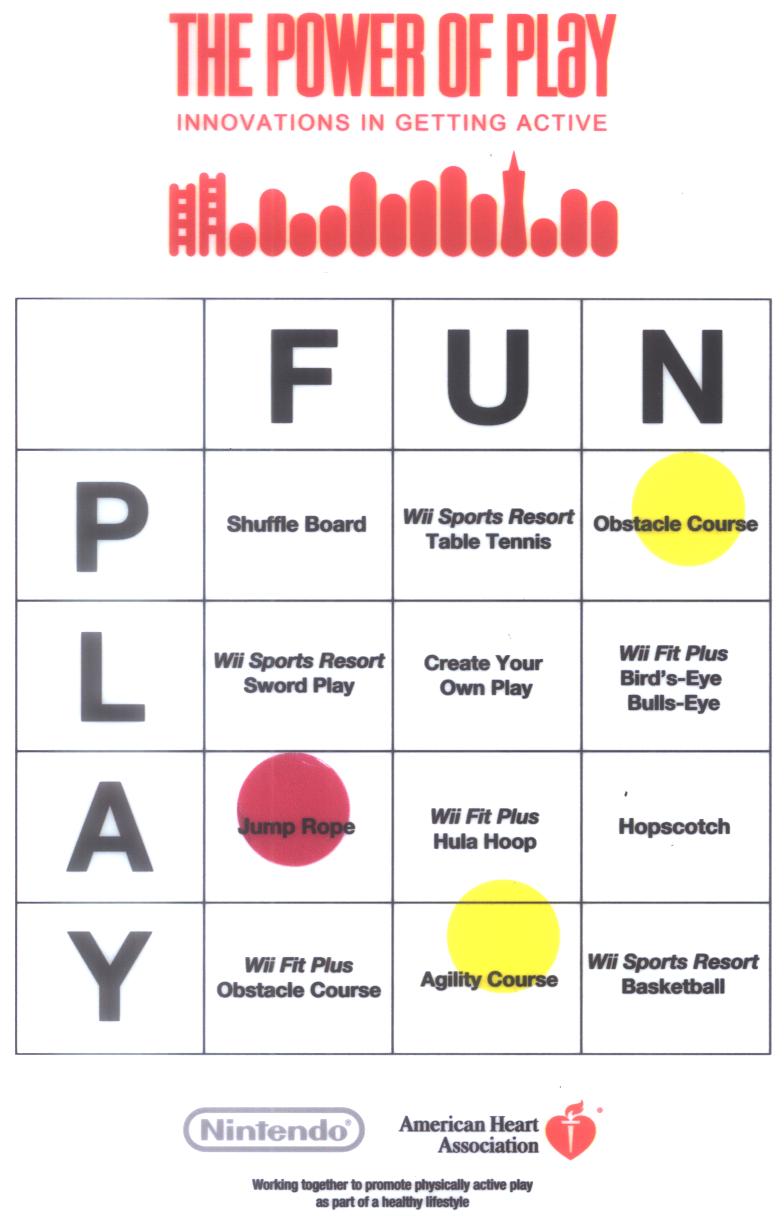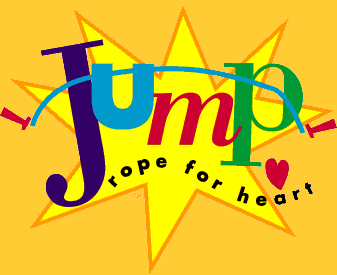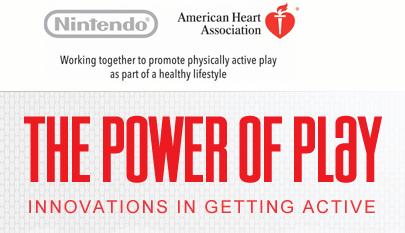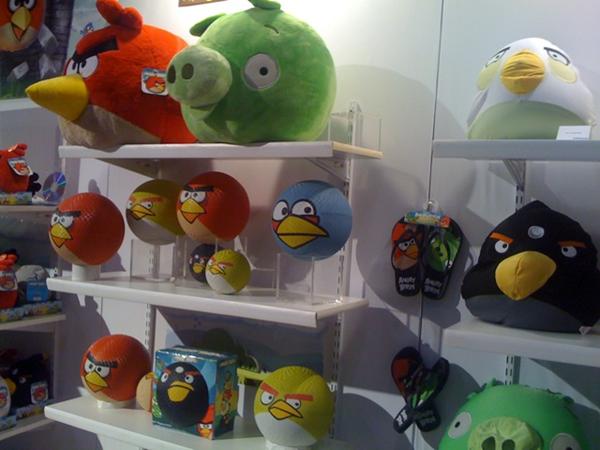 Feb. 15, 2011 “What if…?” Those two words have ignited innovation for centuries, so what better way to harness the Power Of Play than pairing health science thought leaders and industry entrepreneurs in a room of no holds barred brainstorming to get active play moving beyond the ever-important recess?
Feb. 15, 2011 “What if…?” Those two words have ignited innovation for centuries, so what better way to harness the Power Of Play than pairing health science thought leaders and industry entrepreneurs in a room of no holds barred brainstorming to get active play moving beyond the ever-important recess?
In Part Three of this Power of Play series, (Part One and Part Two here) we’ll take a peek at the ‘what ifs’ tumbling off the tongues of kids advocacy pros, educators, scientists, and gaming gurus at the AHA Nintendo summit last month to amp up the ‘sit less, move more’ theme in bold refreshing ways…and to look at “the play ethic” (fabulous presentation by Scottish author and play theorist Pat Kane, from his book by the same name after the jump) as well as the role for gaming in learning (another great piece here featuring Will Wright, the man behind Spore and The Sims).
Rather than look at learning and play as separate experiences (‘recess’ to get AWAY from the sedentary brain time in classrooms) what if we incorporate active play INTO learning in fresh, experiential ways to yield higher achievement through engagement and movement?
 No secret that integration of academics and physicality engages kids…
No secret that integration of academics and physicality engages kids…
…Whether it’s subtle shifts like we do with Shaping Youth media literacy where we rotate stations instead of sitting still, or jump up and down with cans in grocery aprons to feel the added burden of extra weight slowing us down in an attempt to connect the dots through kinetic ‘aha’ moments, it’s critical to not just show and tell, but engage and PLAY rather than interact as sage on the stage offering educator snore fests…
Since the Power Of Play summit involved gaming industry gurus AND those with public health alliances, the next step in this thinking was tossing out the idea of how active play video game experiences might apply to education and learning…
Would it help or hinder? Engage or distract to add screen media into an edu-play school mix?
As an idea hamster by trade, I could almost feel myself being placed onto the wheel in research style to churn out best practices and data nuggets to “report out” how active play video game experiences in education might work…
Media literacy caveat: I’m well aware this smacks of focus group thinking and picking brains for free, but for stakeholders in kids health and well being, it’s a small price to pay to be exposed to top minds in healthcare, science and industry who can actually take this ideation and turn it into solutions-building fruition in a snap…
So yes, I willingly played in this corporate space, (which is almost a productization ‘race’) to add to the conversation on how playful media might ‘work’ in education. (in my ad agency days, we used to call this ‘spec’ work, in the hopes we’d come up with a useful win)
Once I let go of my ‘wean from the screen’ bias since I’m an avid coalition member of the NCLI (No Child Left INSIDE) environmental movement to incorporate the outdoors into the classroom, I embraced endless possibilities of how educators could ALSO use media games with physicality in fresh new ways. (Note the ‘and’ not ‘or’ approach to cognition and physical activity BOTH indoors and out.)
 The AHA/Nintendo alliance asked us what we thought were the top three ‘opportunities and challenges’ in the next five years to adding active play video games into classroom setting, which catapulted our creative crew into full tilt augmented reality and virtual worlds futuristic immersion…
The AHA/Nintendo alliance asked us what we thought were the top three ‘opportunities and challenges’ in the next five years to adding active play video games into classroom setting, which catapulted our creative crew into full tilt augmented reality and virtual worlds futuristic immersion…
We let loose with ideas ranging from experiencing history through hoisting sails on tallships and rowing like galley slaves in Ben Hur style (yah, those were mine) to aiding discovery via GPS mobile phone geocaching style scavenger hunts bridging in/out of the classroom on/offline team building fun.
We talked about what could be done with history’s duels and perils, from urgent horseback riding (Paul Revere, George Washington galloping, jumping, etc) to running from a dragon/fantasy play in literature with web-based games where stories could unfold with sensors (on or in-game) reaching new levels with knowledge and activity acquisition in tandem…
One colleague mentioned the notion of integrating active media like Alvin Ailey dance performances via screen to kinetically inspire, taking the success of games like Dance Dance Revolution to a whole new level, beyond recess and into lesson plans…(see 12-pg pdf case history fm Stanford on DDR’s success)
I brought up the music and arts cutbacks being able to come alive again in virtual worlds and online re-creations, like jazz history in UC Berkeley’s “Remembering 7th Street: Virtual Oakland Jazz and Blues” in ‘you are there’ uber-coolness. And it’s not a big leap to see how this could be turned into active dance and screen exer-learning environments to inspire kids in a media language from their own sphere.
Academics flung terms like neuro-cognition and biomarkers (what kids can learn/boosting brain power w/gross motor skills, etc.) to turn ‘screen time into seen time’ sharing inspirations like the Olympics, wisdom through generations, opportunities to harness energy on and off the grid, and creating greener game spaces.
Much discussion centered around how to use games as a catalyst to teach, scale, collaborate and excel for example in team-based challenge oriented games that lead kids through both a topic and an activity in fresh new ways.
Across from me, young sharpshooter Brendan Scully from Metaio augmented reality transported my brain into an ‘Institute for the Future’ education dreamscape, thinking about 3-D masques, in-game uses for visual incentives (new gizmos/shield/powers earned etc) activity commerce markets, and so many cool ways health could blend into psychosocial settings in “Wii Are Family” mode, taking it to another level with the vast possibilities and latest hacks taking place using Microsoft’s Kinect…(there’s an entire site called KinectHacks.net and reading this latest AdAge article on Kinect, it sounds like it’s part of the Microsoft branding strategy to embrace same.)
Challenges to active gaming/video play in learning environs?
 Concerns ranged from difficulties in defining active play and the power and potential of using the play ethic in learning, along with basic buy-in by school administrators and parents (‘school is not for video games’ argument) to pragmatics (Wii/Kinect various gaming systems upkeep, training and acquisition. access/cost, breakdowns/repair, etc) to over-arching issues like liability (physicality, indoor/outdoor geocache/edu play, etc) but overall there were very few ‘hard stops’ in terms of the bridges and possibilities between media and education…particularly when viewed from the eyes of the most basic device kids often have at the ready, the use of mobile.
Concerns ranged from difficulties in defining active play and the power and potential of using the play ethic in learning, along with basic buy-in by school administrators and parents (‘school is not for video games’ argument) to pragmatics (Wii/Kinect various gaming systems upkeep, training and acquisition. access/cost, breakdowns/repair, etc) to over-arching issues like liability (physicality, indoor/outdoor geocache/edu play, etc) but overall there were very few ‘hard stops’ in terms of the bridges and possibilities between media and education…particularly when viewed from the eyes of the most basic device kids often have at the ready, the use of mobile.
In one of those “hey, I was looking for you to interview” moments, I found myself sitting smack dab next to Jonathan Attwood, CEO from Zamzee who’s teamed with Hope Lab to get kids moving by offering an online rewards program powered by kids’ physical activity in what I lightly call ‘burn and earn’ strategy…
Their Zamzee Co social enterprise hopes to get kids moving by converting energy expended to acquisition of ‘stuff’ in carrot and stick incentives. The Zamzee site said teens tested spent over 10,000 days wearing a Zamzee and had so much fun with it, they ended up moving around 30% more –equal to running nearly an extra marathon a month. Can’t wait to hear more…
It’s slated to launch this year, (see video of Hope Lab’s Richard Tate doing a demo of Zamzee at the fall 2010 Health2.0 conference for a preview) and I’ll be interviewing John Attwood at Zamzee in full to find out about the ‘consumption’ side of this food chain later (partner deals, products, etc)
The upward growth of the ‘gamification’ movement in general makes this ‘rewards’ concept an interesting one, particularly for the “lowest 20%” (least fit kids) who need to get up and get moving the most.
Not sure how the access/affordability/price points would work yet using devices that fall in the ‘durable medical equipment’ category of goods, or how accelerometers and such integrate with schools, but am eager to explore all of it further…
Once our little table of ‘idea hamsters’ extended the conversation out of the education day and opened the door to recess and other active play pre/post school experiences, ideas uncorked for vast open source uses of mobile social challenges too.
We talked about ‘viral learning’ and Contagion Health peer to peer play theories like Jen McCabe’s “I Move You” motivations–‘if this, then this’ to infuse motion-based play into Facebook, apps, widgets, and other mobile/social platforms using SMS and incentives to engage friends to come along into the fun.
 Harkening back to the talk by Elizabeth Cushing of Playworks who asked that gaming execs please keep in mind the concept of turning online games into OFFline experiences (see this year’s ToyFair 2011 debuting Angry Bird Dodgeball, and a Tetris board game –photos via Amy Kraft of Media Macaroni) we also discussed how schools could integrate win-win solutions using other forms of media (apps, mhealth or otherwise) to get kids up and moving fast…(e.g. musical chairs for the iPhone segues to facilitated on/offline in a snap)
Harkening back to the talk by Elizabeth Cushing of Playworks who asked that gaming execs please keep in mind the concept of turning online games into OFFline experiences (see this year’s ToyFair 2011 debuting Angry Bird Dodgeball, and a Tetris board game –photos via Amy Kraft of Media Macaroni) we also discussed how schools could integrate win-win solutions using other forms of media (apps, mhealth or otherwise) to get kids up and moving fast…(e.g. musical chairs for the iPhone segues to facilitated on/offline in a snap)
Big picture, social norming of ‘active play’ into a gaming experience (not just an athletic/exertion one or an outdoor free play variant) seemed to be a universal given…reinforcing that ‘game’ is no longer a four letter word to trump ‘play’ and it should be used as an ADDITION to not a REPLACEMENT OF free play and other experiential socioemotional learning.
Demo of Zamzee by Hope Lab’s Richard Tate at Health2.0 2010
Next up, Part 4 in Power of Play looking at behavior change, ripple effects, social graphs and how institutions of all kinds (workplace, school, home front, etc.) can benefit from peer to peer nudges toward more exertion using media as a positive influence as the distribution channel for fun.
AND…more on ways to ‘bridge’ online and offline experiences, such as FunGoPlay, (kind of a Webkinz-style monetization of sports gear; purported to be an online game rewarding kids for playing outside)
Whys/Hows To Get Kids Moving Toward Active Learning
Transcript for Power of Play Summit (WhatTheHashtag)
CDC: More Strokes Hitting Young (& Middle-aged) Folks
How to Integrate Classroom Academics with Physical Activities
Active Gaming Battles Obesity, Boosts Learning (USF/edu)
Konami: Case History For Success of DDR Exergaming (Stanford)
How An Online Game Plans To Reward Kids for Playing Outside
The Play Ethic (Exploring the Power & Potential of Play)
Pat Kane: Advocating Play (Exc Slideshare/YouTube presos)
The State of Play: Studies/Research (Playworks)
Dot Earth: A Role In Gaming For Learning
Educators Connect Digital Games To Learning (Vgalt.com)
Making Active Gaming Accessible for the Blind: AbleGamers
Want to Get Your Kids Into College? Let Them Play (CNN)
Remote Impact: Exertion Interfaces/Rsch (F.Mueller)
Be A Gamer, Save the World (Jane McGonigal/WSJ)
Games For Change: IFTF Jane McGonigal Video Interview
Kids @Play Summit: Highlights from CES 2011 (Cooney Ctr)










im looking for more info on angry birds http://www.anyplr.com/article-on-angry-birds/